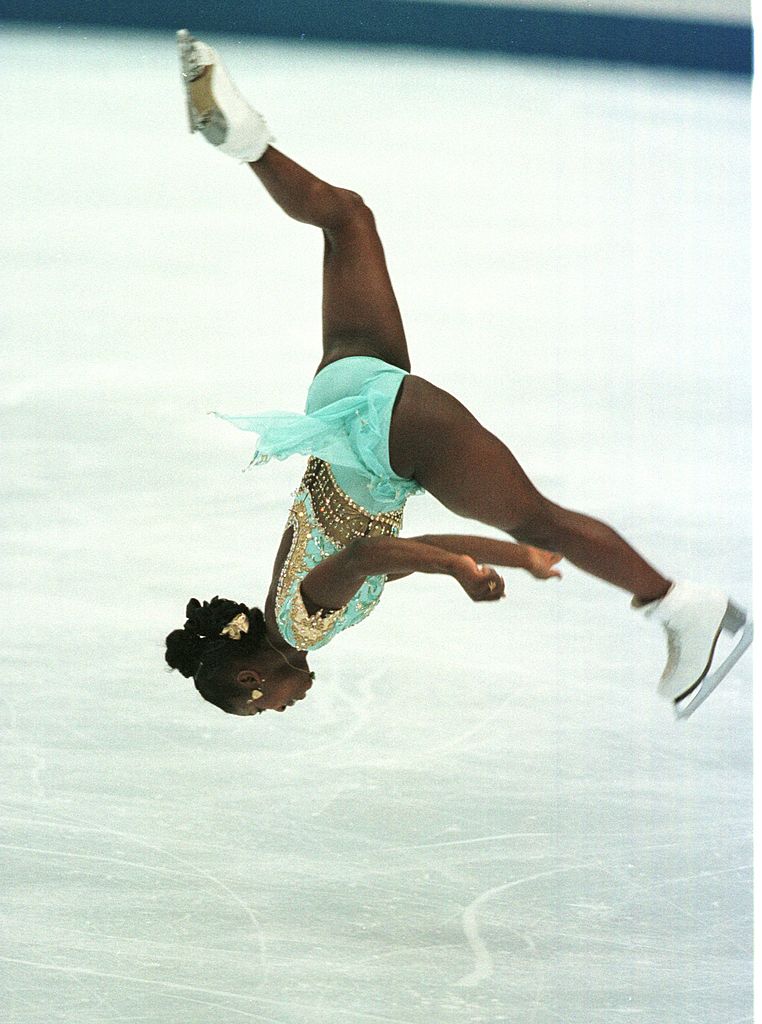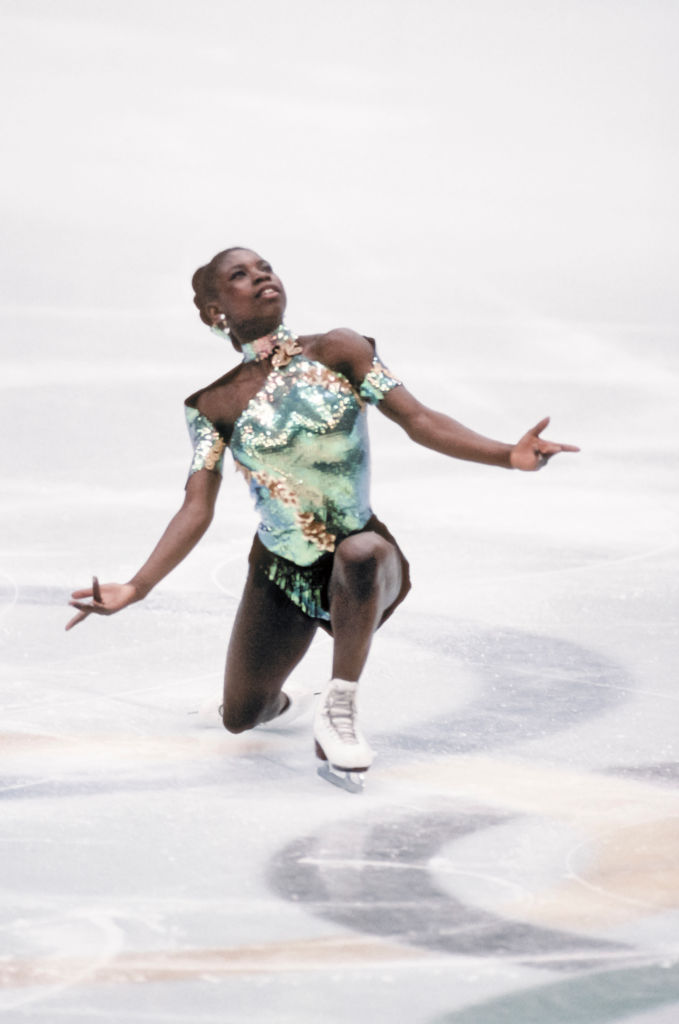Olympian Surya Bonaly may be best remembered for rattling the judges during her 1998 Nagano Olympics free program when she—gasp!—performed a backflip. Backflips were, and still are, illegal in competitions according to the International Skating Union (ISU).
Bonaly’s daring wasn’t just limited to flouting the rules, but about pushing them as well. Six years earlier, at the 1992 Olympics, Bonaly had tried to make history with a jump that will be more familiar for today’s Olympics audience when she almost became the first women’s figure skater to land a quadruple jump at an international competition. She landed it, but about a quarter-turn short of four turns in the air; judges deemed her attempt was underrotated and didn’t validate it as a quadruple jump.
“I did not have the idea of being the first woman to do a quad,” Bonaly tells TIME from Las Vegas, where she now coaches full time. “It was, ‘Hey, I can do triples so now what’s next?’ When you know how to do some elements, you always try to raise the bar and do something different, and not stick to the same things forever. I thought it would be good for me, because I was also very athletic, I could just try and work on [quad jumps].”
Russia’s Kamila Valieva became the first woman to land a quadruple jump at the Olympics on Feb. 7 during the team event. However, that feat is now overshadowed by the fact that she tested positive for a banned substance in December, and is surrounded by questions about the methods of some figure skating coaches whose athletes land such difficult jumps.
While Valieva is certainly the focus of the Beijing Games, she isn’t the only one bringing attention to quadruple jumps in women’s skating. More skaters are training and trying to incorporate quad jumps into their programs, largely in response to the changed scoring system implemented in 2006, which rewards skaters for high scoring skating elements like jumps—the more revolutions, the more points they earn. (Though ISU rules still don’t allow women skaters to include quad jumps in the short program, however, only in the free.) They also reflect the increasing athleticism in women’s figure skating—a trend that Bonaly tried to catalyze during her competitive career.
Read more: The Russian School at the Center of the Controversial Beijing Olympics Women’s Figure Skating Event
“I don’t know why it took so long” for women figure skaters to compete with quadruple jumps, Bonaly says. “For years everybody tried to keep the ladies pretty and not look like athletes. The mentality was that men could quadruple jumps and look like a warrior or big hero, and the girls should stay pretty like princesses.”

‘It was not like a suicidal jump for me’
For Bonaly, adding another revolution to her arsenal of triple jumps wasn’t a huge technical leap, nor, she says, a dangerous one. “I knew it was something in my power to do. It was not like a suicidal jump for me.”
Her coach was eager for her to try quad jumps, and Bonaly says back when she was training, in the 1980s and 1990s, skaters didn’t wear helmets or have other technical tools for helping them learn new jump skills. Even harnesses, which strap skaters into a harness hooked to the ceiling of the rink that the coach can pull to launch skaters into the air while they turn, weren’t that common then. Plus, Bonaly says since she learned all her jumps without a harness, being strapped into the equipment messed up her sense of where she was in the air and made her more uncomfortable. For her, it was easier to learn the quad jumps old-school style. “It was just using extra pads if you needed it, and going for it,” she says. “We didn’t have fancy technology; we tried and if we fell, well, we put more pads on or used ice packs after and that was it.”
Bonaly says she landed most of the quadruple jumps—the Salchow, toe loop, flip, and Lutz—in practice, but was never able to cleanly complete the four rotations in a competition.
A fully validated quad at a women’s skating event didn’t happen until 2002 when Miki Ando of Japan successfully executed a quadruple salchow at the Junior Grand Prix Final. Ando tried to land the first quad at an Olympics, in 2006 but fell and only received credit for a triple.
U.S. figure skater Sasha Cohen landed a few tightly executed quads in practice at an event in 2001, but not during the competition. It wasn’t until 2018 that Russian teen Alexandra Trusova, then 13, again landed a quadruple in competition—the quad toe loop, at the Junior Grand Prix Lithuania. U.S. figure skater Alysa Liu became the first American woman to land a quad in competition in 2019, at a Junior Grand Prix event. Liu has since grown several inches taller, which has affected her jumping, and she did not include a quad jump in her free program this season.
Read More: The Battle Over Kamila Valieva’s Drug Test Is Just Beginning
In contrast, Trusova, who trains with Valieva, has quickly become the queen of quads; she holds Guinness Records as the first female to successfully land the quad Lutz, the quad flip, and the quad toe loop jumps. She is also the first and only female skater to compete with these four different jumps (including the salchow) in quad form.
‘If you really want to survive in the skating world, you need to do a quad’
Trusova isn’t the only Russian figure skater building her programs around quad jumps. Her Olympic teammate Anna Shcherbakova, who also trains at the same school in Moscow, is also an accomplished jumper. So to set herself apart, Trusova has incorporated five quad jumps in her free program, a feat that only male figure skaters have done to date.
The new ISU rules favor programs like these. Rather than starting all skaters from the same perfect base score, and deducting for missed elements or subpar performance, now skaters can build programs with any combination of skills they desire, so more skilled skaters able to land harder jumps can pile up higher scores than those who land easier ones. “Everybody now knows if you really want to survive in the skating world, you need to do a quad,” says Bonaly.

How challenging are the quadruple jumps that both women and men are now landing? “At this level, it’s hyper-technical, and you need very strict technique because one little mistake throws you off,” says Bonaly. “It’s fine if you make a mistake for a single, and for a double, it’s also okay. But during a quad a mistake and lead to a body slam and you don’t want that. It’s all about routine, and repeating it over and over.”
That training can be brutal on the body, and the extreme demands, especially for young girls, have raised questions about the price that comes with pushing the boundaries of the sport. Valieva’s doping violation only focused more attention on those sacrifices and the need to ensure that progress doesn’t come at the expense of safety and clean sport.
More Must-Reads from TIME
- Caitlin Clark Is TIME's 2024 Athlete of the Year
- Where Trump 2.0 Will Differ From 1.0
- Is Intermittent Fasting Good or Bad for You?
- The 100 Must-Read Books of 2024
- Column: If Optimism Feels Ridiculous Now, Try Hope
- The Future of Climate Action Is Trade Policy
- FX’s Say Nothing Is the Must-Watch Political Thriller of 2024
- Merle Bombardieri Is Helping People Make the Baby Decision
Contact us at letters@time.com